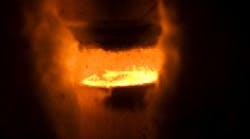A technique to directly produce hydrogen and carbon monoxide from biomass liquids has been developed by researchers at the University of Minnesota, Minneapolis. Their reactive flash volatilization process makes the synthesis gas at least 10 times faster than conventional gasification technology, says Lanny Schmidt, professor of chemical engineering and materials science at the school and leader of the team behind the process.
The big problem in biomass conversion is economics now gasification can only be done in large reactors with about-1-sec. residence times, he notes. The new technique will allow equipment to be one-tenth the size or smaller and significantly cheaper for a given throughput, he believes.
Figure 1. Tiny unit relies on high temperature and rhodium-cerium catalyst to produce high yield of hydrogen gas from soy oil.
While tests have used refined soy oil and glucose solution, in the real world waste liquid would be the feedstock, Schmidt explains. Its a way to take worthless biomass and turn it into useful fuels and chemicals, he adds. The route could supply hydrogen for fuel cells and feedstock for the production of dimethyl ether to make synthetic diesel fuel or to replace propane, he notes, if those markets develop.
In the technique, methane and oxygen are fed into a reactor to heat a porous ceramic disk containing a rhodium-cerium catalyst to about 1,000°C. Then, the methane flow is cut off and an injector sprays fine droplets of the biomass liquid through a tube onto the catalyst. The ensuing exothermic reaction maintains the bed temperature. This high temperature prevents formation of char. About 70% of the hydrogen is transformed in H2, with the remainder forming water and small amounts of ethylene and propylene. (The process can be tuned to make more ethylene and propylene if desired, says Schmidt, by limiting oxygen to the reactor and tweaking the catalyst system.)
Residence time is about 50 milliseconds. The laboratory reactor employs a catalyst disk about 2.5 cm. in diameter and about 1-cm thick and can process about 1 lb. of liquid per day. The team has run the continuous reactor for 20 hours with no catalyst deactivation, he adds.
Viscosity of the liquid feed isnt an issue, Schmidt says. While the automotive fuel injector now used in the laboratory to create droplets doesnt suit high viscosity liquids, other hardware could handle such fluids.
The automotive injector does limit throughput, adds Schmidt. The researchers are now using alternative methods to produce droplets and this should allow considerably higher production rates, he says. In addition, droplet size has been far from optimal and the other methods should be able to form droplets in the 50 to 100 micron range desired, he notes.
Additional work focuses on examining the effect of contaminants in feeds. After all, waste biomass liquids invariably contain impurities such as potassium and phosphorus compounds, notes Schmidt. We think the catalyst is fairly poison resistant, he says.
Schmidt stresses that while the researchers are continuing to develop the technology the aim is to have an industrial firm take over for piloting the route. Such piloting could be done almost immediately, he says, adding that several companies have contacted him about the technology.
